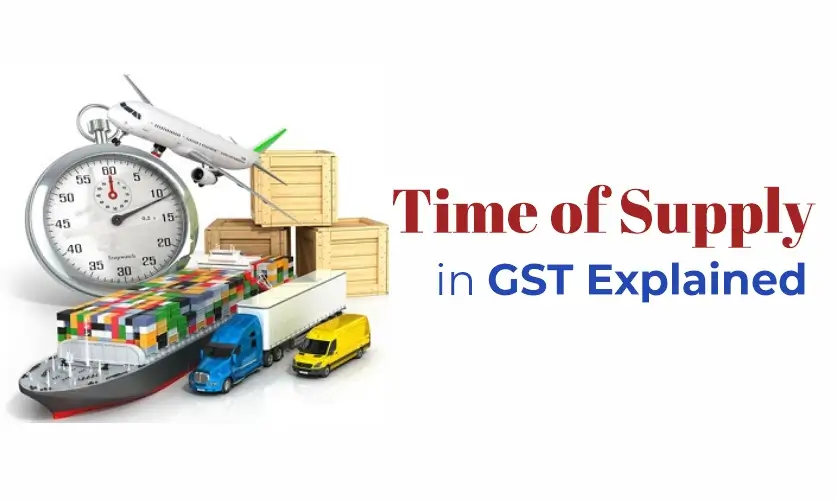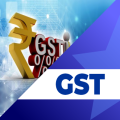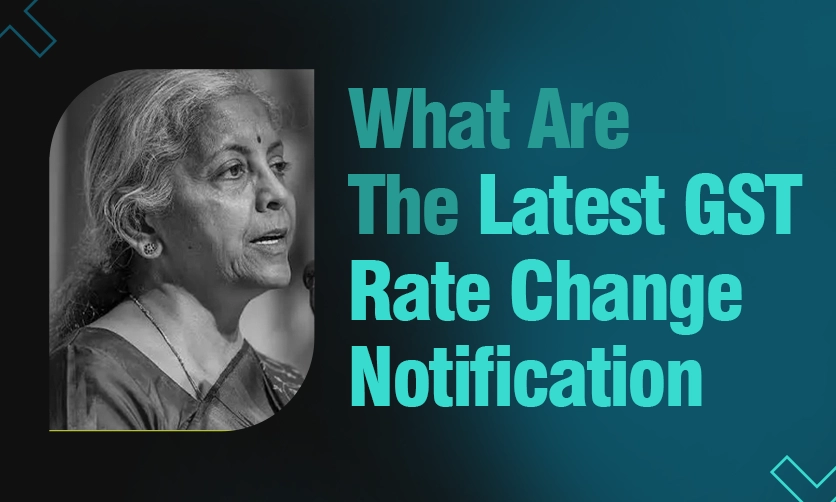
Time of Supply in GST Explained
Time of Supply in GST is the time when a GST taxpayer owes GST for a transaction. It is important to understand this GST regime because it determines when a taxpayer is liable to pay GST.
Many basic concepts of GST need to be understood for accurate filing. Keeping our valuable readers in mind, we are again here with one more GST Guide. Keep reading to enhance your knowledge and skills.
In this guide, we will explain to you what the time of supply in GST means. We will elaborate on our discussion of both the forward charge and reverse charge mechanisms of time of supply in GST. You can analyze them and choose the one that fits your business requirements.
Table of Contents
-
- What is the Time of Supply in GST?
- Importance of Time of Supply
- Time of Supply Under Different Scenarios
- Time of Supply under Forward Charge for Goods and Services
- Time of Supply under Reverse Charge for Goods and Services in GST
- Time of Supply for Vouchers
- How to Determine the Time of Supply in GST When Rates Change
- Special Cases and Their Time of Supply
- FAQ(Frequently Asked Questions)
What is the Time of Supply in GST?
Time of Supply in GST is the time when a business owes GST on a sale.
Time of supply is an important factor in GST because it assures that businesses will pay accurate GST within the mentioned time limit. The most important aspect of this is to ensure that there is no missed payment of taxes. It helps the government to receive the GST revenue and its due correctly.
Let’s illustrate the Time of supply in GST with the example:
A business sells a product to a customer on August 1st. The customer paid for the product on August 10th. The TOS for this transaction is August 1st because the sale was completed on that day. The business owes GST on the sale on August 1st, even though the customer did not pay for the product until August 10th.
ToS is a bit complex in structure, and there are different sets of rules for different types of transactions. However, it is an important concept to understand for any business that is registered for GST.
Importance of Time of Supply
Understanding the Time of Supply in GST (ToS) is essential for several reasons:
- To determine when to pay GST: The ToS system is built with the concept that it determines when businesses have to pay GST on a particular transaction. It ensures that you are following GST laws and can avoid penalties.
- To Claim Input Tax Credit (ITC): ITC is defined as a tax credit that businesses can claim on the GST they have paid on their inputs. To get ITC for your businesses, make sure that your suppliers have paid the GST on the outputs they have received.
- To file GST returns accurately: Businesses have to ensure that their GST returns are filed regularly and report tax liability for the previous period. ToS helps businesses check the correct tax liability to report on each return.
- To manage cash flow effectively: By knowing when they owe GST, businesses can plan their cash flow accordingly and avoid unexpected tax payments.
Time of Supply Under Different Scenarios
The Time of Supply in GST for a transaction can vary depending on the type of transaction and the nature of the goods or services being supplied. Here are some common scenarios and how ToS are determined in each case:
- Sale of goods: The time of supply for a sale of goods is the date on which the goods are delivered to the buyer. In other words, it is the date on which the buyer makes the goods available to the seller.
- Provision of services: The time of supply for a provision of services is the date on which the services are completed. We can also say it is the date on which the recipient makes the payment to the supplier.
- Supply of goods on consignment: The ToS for a supply of goods on consignment is the date on which the goods are sold to the customer. You can also consider it as the date When the customer pays the supplier
- Supply of goods on credit: It is the date for a supply of goods on credit on which the goods are received by the buyer. It is also defined as the date on which the invoice is issued to the buyer.
- Import of goods: The ToS for an import of goods is the date on which the goods are cleared by customs.
- Export of goods: The ToS for export is the date on which the goods are shipped out of the country.
It is important to note that there are special rules for determining the time of supply under GST in some instances. For example, the supply of works contracts, the supply of immovable property, and the supply of goods or services through an electronic commerce platform.
GST Basic Concepts – Ultimate Guide for Students
GST Return Types: Due Dates and Filing Procedures
Types of GST in India: IGST, SGST, CGST & UTGST Made Easy for Students
Let’s move in more depth for a better understanding of the Time of Supply under GST. Hopefully, the information will guide you to understand it easily.
Time of Supply under Forward Charge for Goods and Services
The time of supply in a GST forward charge is the moment when a supplier becomes liable to pay GST on the sale of goods or services. It is a critical concept for businesses, as it determines when they must charge and pay GST to the government.
Accurately determining the time of supply is essential for legal compliance, claiming an input tax credit, managing cash flows, and maintaining a good business reputation. In short, it marks the point when the GST liability arises for the supplier, shaping their financial and tax-related activities.
We have explained in the next section in more detail the time of supply of Goods and services in GST. Take a look at each one by one.
Time of Supply of Goods Under Forward Charge in GST
A Forward charge is a mechanism where the supplier is liable to pay GST. The Time of Supply (ToS) of goods under forward charge is determined as follows:
- Invoice issuing: For most goods and services, the time of supply is the earlier of
-
- The date the invoice is issued.
- On the last day, the supplier is required to issue an invoice.
- Advance payments: In case the supplier receives the payment early without issuing an invoice. The time of supply of goods is the date when payment is received. However, if the invoice is issued within the prescribed period, the ToS will be based on the invoice date.
- Continuous supply of goods: In cases where there is a continuous supply of goods, the due date for payment can be found in the contract. You can make the ToS in this way:
- The date the amount is entered in the books of accounts.
- The date the payment is debited from the recipient’s bank account or credited to the supplier’s bank account.
Manage Multiple GST in TallyPrime Release 3.0 – A Step-by-Step Guide
Simplifying Accounting: E-Invoice in Tally Prime
GST Reconciliation in TallyPrime: A Comprehensive Guide with Real-Life Examples
GST Reporting: Complete Overview of 2-Factor Authentication in GST
Time of Supply of Services Under Forward Charge
The Time of Supply of services under forward charge is calculated similarly to the ToS for goods:
- Invoice issuance: The time of supply of services is considered based on invoice issue timing. Let’s see the following two cases when it can occur:
- Firstly, the date the invoice is issued.
- Secondly, when the supplier issues an invoice on the last day of the requirement.
- Advance payments: if the supplier receives payment before issuing an invoice, the GST liability arises on the date the payment is received. However, if the supplier issues an invoice within the prescribed period, the GST liability arises on the invoice date.
- Continuous supply of services: In cases of continuous supply of services, the due date for payment can be determined from the contract. The ToS takes place in the following:
- The date when the amount is added to the books of accounts.
- The date the payment is processed and completes the transfer from the recipient’s bank account to the supplier’s bank account.
Time of Supply under Reverse Charge for Goods and Services in GST
The time of supply in GST reverse charge is the moment when the recipient of goods or services becomes liable to pay GST to the government instead of the supplier. This typically occurs when the recipient records the transaction in their books, makes the payment, or receives the goods, whichever happens first.
The reverse charge mechanism is crucial for businesses to ensure timely tax compliance and the accurate calculation of tax liabilities. It also helps to prevent tax evasion and ensure that the government collects the correct amount of GST.
Understanding the time of supply under reverse charge is vital for businesses engaged in such transactions to avoid any penalties or legal issues. For example, if a business fails to pay GST on a reverse charge transaction, it may be subject to penalties and interest.
If you are searching to learn complete GST under expert guidance, then we are here to help you.
Check out the below courses

Time of Supply of Goods Under Reverse Charge in GST.
Under the reverse charge mechanism, the recipient is responsible for paying GST. The Time of Supply for goods under reverse charge is noted in the following cases:
- Invoice Issue Date: If the supplier issues an invoice, then that particular invoice issue date is marked as Time of Supply.
- No invoice issued: If the supplier fails to generate an invoice within the mentioned time frame, in that scenario, the ToS is the date the recipient receives the goods.
Mastering SAC Codes: Key to GST Compliance
Reverse Charge Mechanism: Key Concepts and Implications
HSN Codes Lookup: Find the Right Code for Your Products
Time of Supply of Services Under Reverse Charge in GST
As we know, in the reverse charge mechanism, one who receives payment has to pay GST. The Time of Supply (ToS) for services under reverse charge is determined as follows:
- Invoice issuance: Time of supply is noted when the supplier issues an invoice.
- No invoice issued: If the supplier does not issue an invoice within the mentioned time limit, the TOS is considered when
- The date of payment made to the supplier.
- The date of entry in the books of accounts.
Time of Supply for Vouchers
The time of supply for vouchers in GST is the date the voucher is issued or the date the voucher is redeemed. It can be the date the voucher expires if it does not fall under the other two conditions, depending on the situation.
- If the supplier issues a voucher before the supply of goods or services. Then the time of supply is the date the voucher is issued.
- If the voucher is issued and then redeemed for goods or services. In this scenario, the time of supply is the date the voucher is redeemed.
For example, A business issued a gift voucher on January 1, 2023. The voucher is redeemed for goods on February 1, 2023. The time of supply for the gift voucher is February 1, 2023, which is the date the voucher was redeemed.
- If the voucher is not redeemed within a specified period and there is no specific date for the issue mentioned. In that case, the time of supply is the date the voucher expires.
For example, A business issued a recharge voucher on January 1, 2023. The voucher is not redeemed for services within the specified period of one year. The time of supply for the recharge voucher is December 31, 2023, which is the date the voucher expires.
It is important to note that there are some exceptions to the general rules for the time of supply for vouchers. For example, the time of supply for vouchers for services provided under reverse charge is the earliest of the following:
- The date of receipt of payment
- The date of issue of the invoice
- The date of completion of the service
How to Determine the Time of Supply in GST When Rates Change
| Scenario | Date of supply of goods and/or services | Issued payment | Collected | Time of supply (TOS) | GST rate to be adopted |
|---|---|---|---|---|---|
| Change in GST rate before the supply (forward charge) | Invoice issued before rate change | N/A | N/A | Date of invoice | GST rate prevailing on the date of invoice |
| Change in GST rate before the supply (forward charge) | Invoice not issued before the rate change | N/A | N/A | Date of supply or receipt of payment, whichever is earlier | GST rate prevailing on the date of supply or receipt of payment, whichever is earlier |
| Change in GST rate after the supply (forward charge) | N/A | N/A | N/A | Determined based on the regular rules (date of invoice, date of supply, or date of payment) | GST rate prevailing on the date of invoice, date of supply, or date of payment, whichever is earlier |
| Change in GST rate under reverse charge | N/A | N/A | N/A | Determined based on when the payment is made to the supplier or when the supplier’s books of accounts are updated, whichever is earlier | GST rate prevailing on the date of payment or date of update in the supplier’s books of accounts, whichever is earlier |
| Change in GST rate for a continuous supply of goods or services | N/A | N/A | N/A | Time of supply for each invoice is determined based on the rate prevailing at the time of issuing that particular invoice | GST rate prevailing on the date of issuing each invoice |
Special Cases and Their Time of Supply
Some industries and cases have special rules for determining the Time of Supply in GST:
Goods Transport Agency (GTA)
For GTA services, the time of supply is determined based on:
- The date the recipient pays the GTA.
- The date the recipient records the payment in their books of accounts.
Works Contract
For works contracts, the time of supply is considered to be:
- The date when the recipient pays an amount to the supplier.
- The date when the supplier recorded the payment in their books of accounts.
Banking and Financial Institutions
For services provided by banking and financial institutions, the ToS is the earlier of
- The date the institution records the entry in their books of accounts.
- The date the payment is debited from or credited to the respective accounts.
FAQ(Frequently Asked Questions)
1.What is the Time of Supply (ToS) under GST and why is it important?
The Time of Supply is the point when the liability to pay GST arises on a supply of goods or services. It determines the applicable GST rate, the due date for tax payment, and compliance requirements like return filing. Separate provisions exist for goods (Section 12, CGST Act) and services (Section 13, CGST Act). Correct ToS ensures proper tax deposition and avoids interest/penalties.
2.What is the general rule for Time of Supply of Goods (Forward Charge)?
Under Section 12(2): The ToS is the earliest of:
- Date of issue of invoice (or last date by which invoice is required under Section 31); or
- Date of receipt of payment (earlier of entry in books or bank credit). For removal of goods without invoice (e.g., branch transfer), it aligns with the date removal triggers invoicing.
3. What is the general rule for Time of Supply of Services (Forward Charge)?
Under Section 13(2): The ToS is the earliest of:
- Date of issue of invoice (if issued within prescribed time under Section 31); or
- Date of receipt of payment; or
- Date of provision of service (if invoice not issued timely); or
- Date when recipient records the service in books (if above not applicable).
4. How is Time of Supply determined under Reverse Charge Mechanism (RCM)?
- For Goods: Earliest of date of receipt of goods, payment, or 31st day after invoice date.
- For Services: Earliest of date of payment, or 61st day after invoice date; or date of book entry if undetermined. Special rule for associated enterprises (supplier outside India): Earlier of book entry or payment date.
5. What is the Time of Supply for Vouchers?
As per amendments effective October 1, 2025 (Finance Act, 2025), provisions for vouchers under Sections 12(4) and 13(4) have been omitted. Vouchers are now treated as instruments of payment (actionable claims under Schedule III), not as supplies of goods/services. Hence, issuance/redemption of vouchers is generally not subject to GST, and no separate ToS applies.
Conclusion
In the GST infrastructure, Time of Supply plays a very important role in determining transactions for businesses, whether they are taxed or owed. Understanding ToS is essential for businesses to comply with GST regulations, claim ITC effectively, manage their cash flow, and file GST returns accurately.
We always try to bring more information to your desk to keep you updated and industry-ready. At any point in time, if you think that you need expert support or courses to learn GST, then check here. It will help you in skill enhancement.
How To Be a Tax Consultant in India?
GST Courses: Career Benefits Explained For Students & Professionals
Indian Tax Structure Simplified
Ultimate GST Audit Checklist (FY 2022-23) for Ensuring Compliance and Avoiding Penalties
Top 15 Common GST Interview Questions and Answers
- Why the ICA Franchise is Your Best Business Move in Revolutionizing Education - January 13, 2026
- 50 Important Rectification Of Errors Questions For Interview - January 5, 2026
- 50 Important Cash Book Questions & Answers For Interview Preparation - January 5, 2026

.jpg)






















